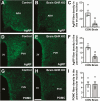Ghrelin-induced Food Intake, but not GH Secretion, Requires the Expression of the GH Receptor in the Brain of Male Mice
- PMID: 33972988
- PMCID: PMC8197284
- DOI: 10.1210/endocr/bqab097
Ghrelin-induced Food Intake, but not GH Secretion, Requires the Expression of the GH Receptor in the Brain of Male Mice
Abstract
Ghrelin stimulates both GH secretion and food intake. The orexigenic action of ghrelin is mainly mediated by neurons that coexpress agouti-related protein (AgRP) and neuropeptide Y (NPY) in the arcuate nucleus of the hypothalamus (ARH). GH also stimulates food intake and, importantly, ARHAgRP/NPY neurons express GH receptor (GHR). Thus, ghrelin-induced GH secretion may contribute to the orexigenic effect of ghrelin. Here, we investigated the response to ghrelin in male mice carrying GHR ablation specifically in neurons (brain GHR knockout [KO] mice) or exclusively in ARHAgRP/NPY neurons (AgRP GHR KO mice). Although brain GHR KO mice showed normal ghrelin-induced increase in plasma GH levels, these mutants lacked the expected orexigenic response to ghrelin. Additionally, brain GHR KO mice displayed reduced hypothalamic levels of Npy and Ghsr mRNA and did not elicit ghrelin-induced c-Fos expression in the ARH. Furthermore, brain GHR KO mice exhibited a prominent reduction in AgRP fiber density in the ARH and paraventricular nucleus of the hypothalamus (PVH). In contrast, AgRP GHR KO mice showed no changes in the hypothalamic Npy and Ghsr mRNAs and conserved ghrelin-induced food intake and c-Fos expression in the ARH. AgRP GHR KO mice displayed a reduced AgRP fiber density (~16%) in the PVH, but this reduction was less than that observed in brain GHR KO mice (~61%). Our findings indicate that GHR signaling in the brain is required for the orexigenic effect of ghrelin, independently of GH action on ARHAgRP/NPY neurons.
Keywords: cytokines; energy balance; growth hormone receptor; hypothalamus.
© The Author(s) 2021. Published by Oxford University Press on behalf of the Endocrine Society. All rights reserved. For permissions, please e-mail: journals.permissions@oup.com.
Figures







Similar articles
-
Fasting and prolonged food restriction differentially affect GH secretion independently of GH receptor signaling in AgRP neurons.J Neuroendocrinol. 2024 Jul;36(7):e13254. doi: 10.1111/jne.13254. Epub 2023 Mar 25. J Neuroendocrinol. 2024. PMID: 36964750
-
Fasting induces remodeling of the orexigenic projections from the arcuate nucleus to the hypothalamic paraventricular nucleus, in a growth hormone secretagogue receptor-dependent manner.Mol Metab. 2020 Feb;32:69-84. doi: 10.1016/j.molmet.2019.11.014. Epub 2019 Dec 16. Mol Metab. 2020. PMID: 32029231 Free PMC article.
-
Ghrelin receptors mediate ghrelin-induced excitation of agouti-related protein/neuropeptide Y but not pro-opiomelanocortin neurons.J Neurochem. 2017 Aug;142(4):512-520. doi: 10.1111/jnc.14080. Epub 2017 Jun 21. J Neurochem. 2017. PMID: 28547758
-
Central mechanisms involved in the orexigenic actions of ghrelin.Peptides. 2011 Nov;32(11):2248-55. doi: 10.1016/j.peptides.2011.05.014. Epub 2011 May 17. Peptides. 2011. PMID: 21619904 Review.
-
Growth hormone inhibits its own secretion by acting on the hypothalamus through its receptors on neuropeptide Y neurons in the arcuate nucleus and somatostatin neurons in the periventricular nucleus.Endocr J. 1998 Apr;45 Suppl:S19-26. doi: 10.1507/endocrj.45.suppl_s19. Endocr J. 1998. PMID: 9790225 Review.
Cited by
-
Growth hormone receptor gene disruption.Vitam Horm. 2023;123:109-149. doi: 10.1016/bs.vh.2022.12.004. Epub 2023 Aug 24. Vitam Horm. 2023. PMID: 37717983 Free PMC article.
-
Ablation of Growth Hormone Receptor in GABAergic Neurons Leads to Increased Pulsatile Growth Hormone Secretion.Endocrinology. 2022 Aug 1;163(8):bqac103. doi: 10.1210/endocr/bqac103. Endocrinology. 2022. PMID: 35803590 Free PMC article.
-
Characterization and Regulation of the Neonatal Growth Hormone Surge.Endocrinology. 2024 Oct 30;165(12):bqae140. doi: 10.1210/endocr/bqae140. Endocrinology. 2024. PMID: 39446366
-
The Pattern of GH Action in the Mouse Brain.Endocrinology. 2024 May 27;165(7):bqae057. doi: 10.1210/endocr/bqae057. Endocrinology. 2024. PMID: 38728240 Free PMC article.
-
Effects of Growth Hormone Receptor Ablation in Corticotropin-Releasing Hormone Cells.Int J Mol Sci. 2021 Sep 14;22(18):9908. doi: 10.3390/ijms22189908. Int J Mol Sci. 2021. PMID: 34576072 Free PMC article.
References
-
- Kojima M, Hosoda H, Date Y, Nakazato M, Matsuo H, Kangawa K. Ghrelin is a growth-hormone-releasing acylated peptide from stomach. Nature. 1999;402(6762):656-660. - PubMed
-
- Arvat E, Di Vito L, Broglio F, et al. Preliminary evidence that Ghrelin, the natural GH secretagogue (GHS)-receptor ligand, strongly stimulates GH secretion in humans. J Endocrinol Invest. 2000;23(8):493-495. - PubMed
-
- Peino R, Baldelli R, Rodriguez-Garcia J, et al. Ghrelin-induced growth hormone secretion in humans. Eur J Endocrinol. 2000;143(6):R11-R14. - PubMed
Publication types
MeSH terms
Substances
Grants and funding
LinkOut - more resources
Full Text Sources
Other Literature Sources
Molecular Biology Databases
Research Materials
Miscellaneous

